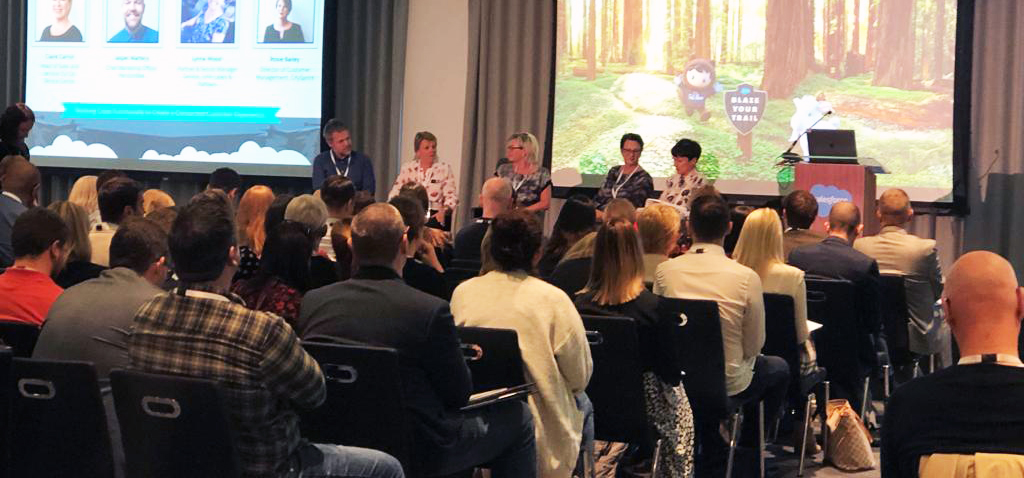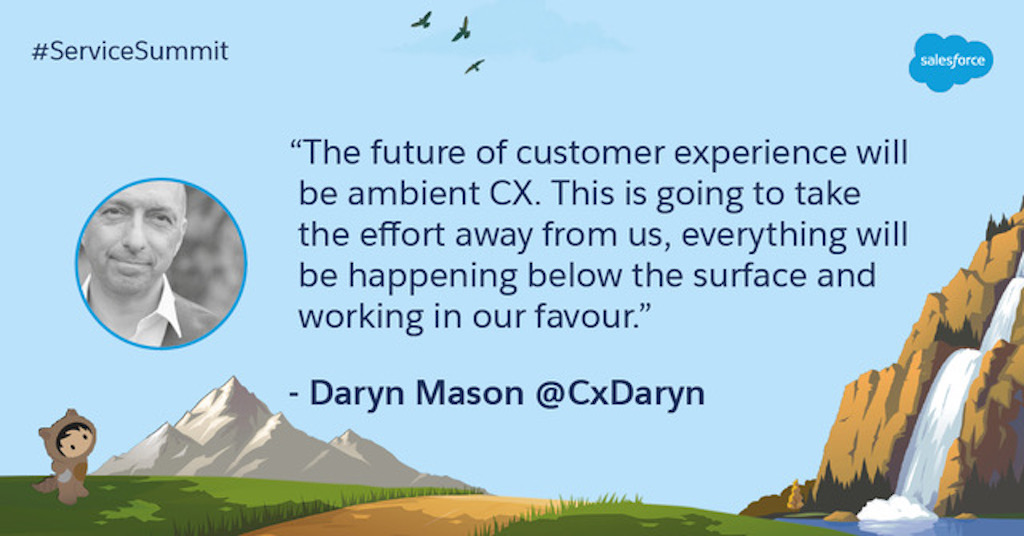This article is a guest post from Customer Experience expert and thought leader, Daryn Mason, who attended our recent Service Summit in London. Here are his key take-aways from the event.
It’s rare to meet a Customer Experience guru who is both a pragmatist and a strategist. Matt Watkinson – author, guru and CEO – perfectly fits this description.
I saw Matt present at Salesforce UK’s Customer Service Summit in London last week, where he gripped the audience with his keynote address, “The Leader’s Guide to Customer Experience”.
The Satisfaction Trap
By holding up a mirror to the customer service industry, he showed how much of our strategic thinking is based on false optimism. Why should higher customer satisfactions scores magically produce higher revenues and reduced costs? He warned of the “satisfaction trap” where organisations chase CSAT or NPS scores as a primary goal and how this often results in disappointment and frustration.
The best advice is often the simplest and no more so than customer service initiatives. Matt urged the leaders in the audience to “move fast and fix things”. This not only results in quick wins at board level, but also makes changes that customers notice. But where should you look first?
Matt explained the concept of the “zone of tolerance” for customers. This is where your service falls nicely between the lines of “ideal” and “just adequate” in your customers’ perceptions. He observed how nobody remembers these experiences. What they do remember are those exceptional experiences above “ideal” or below “adequate”. By optimising the former and eliminating the latter, you can make big differences quickly!
“Expectation shape our perceptions” of customer experience, Matt went on to explain. So companies need to decide exactly what their “experiential signature” is. Are you an Amazon, focused on an effortless, stress-free experience, or a High Street bookstore, offering a more social and sensory experience? He urged the audience to decide what their experiential signature is and ruthlessly focus on delivering it.
You can watch a video interview from the Service Summit with Matt on Twitter.
UK Customer Service: A Reality Check
Jo Causon is a speaker with statistics. She’s also the CEO of The Institute for Customer Service, so knows a thing or two about customer experience. Jo presented a plethora of research statistics perfectly profiling the current state of customer service in the UK.
It’s astonishing to think that £122 billion is lost to the annual UK economy through poor customer service. According to the latest UK Customer Service Index, it’s not getting any better. Jo explained that the perennial leaders – like First Direct and John Lewis – seem to have found a repeatable formula for success, but others tend to yo-yo up and down the index rankings.
Her core message to attendees was to create sustainable strategies for customer service excellence, rather than tactical, transient improvements.

In Search of Best Practice
What do beekeepers, couriers and undertakers have in common? Well, in the context of today’s Summit, it’s exceptional customer service. Salesforce’s Helen Kelisky assembled a panel of diverse brands who have all cracked the code of delivering high quality customer experiences. What advice would they give to their peers?
- Jasper Martens, CMO of PensionBee, explained the challenge of convincing customers to trust their retirement funds to a start-up company. He described how customers are assigned a personal advisor – or beekeeper – to explain every step of the pension process and the choices to be made. He cautioned the audience to be realistic with implementation timescales.
- John Lewis Partnership are renowned for unrivalled retail service (and came 2nd in the latest UK Customer Service Index). Lynne Wood, Senior Divisional Manager, observed that their customers’ patience levels are constantly eroding. Her team are always balancing value, capacity and capability to meet increasing expectations. She urged those listening to think carefully about the full consequences of their actions across the entire organisation, not just their own department.
- The Co-Op Group may have been around for over 170 years, but they are at the forefront of customer service thinking in the UK. Their Head of Sales and Service, Claire Carroll, is driving CX transformation. For example, she revealed how all customer service advisors have their own Amazon account to compensate customers for mistakes, and how empathy is core to their ethos. This is especially true in areas of their business like Funeral Services where emotions are fragile. And when it comes to persuading the Board of why CX is critical, she advised attendees to have plenty of real customer stories in their back-pocket to quote whenever required.
- Using a same-day courier is often a “distress purchase”, according to Rosie Bailey, Business Development Director for CitySprint UK. She highlighted how delivering great customer service in tight timescales requires deep collaboration and synchronisation of people, process and technology. Rosie explained how Salesforce experts and their wider community of users had been invaluable to helping them deliver excellence!
What does the future hold?
The afternoon of the Service Summit was devoted to gazing into the future and the trajectory of current trends. Katherine von Jan from the Salesforce Office of Innovation took centre stage to explain five ways that Service will be reimagined. They all rang true with an audience hungry for insights.
- Service is the Product – Now that most customers are choosing brands based on their experience, your service drives loyalty and, therefore, value.
- Problems Fix Themselves – With the relentless march of AI and machine learning, our aim should be to identify and fix problems before customers even knows they’re there.
- Everyone is in Service – Given the critical importance of the customer experience, your entire organisation needs to adopt a service culture.
- The Future is More Human – Everyone wants a more personal, human touch. Rather than technology making experiences more impersonal, it should free your hands to deliver human experiences where they’re most needed.
- Ethics are Not Optional – Unless organisations use technology responsibly, there will be a huge digital backlash that could kill your brand. Trust is more important than ever in customer relationships of the future.
With these thoughts ringing in their ears, attendees were invited to join subject-specific workshops to discuss and debate the implications for areas such as skills in the workforce, mobile computing and artificial intelligence.
Fast Forward …
With the brake-neck pace of technological innovation and adoption, it’s almost impossible to imagine what customer service will feel like in five years’ time. But this doesn’t stop our curiosity. To satisfy this thirst, Salesforce’s SVP of Product Marketing and Strategy, Sarah Patterson, joined Katherine von Jan to entertain the audience with a few scenarios and role plays illustrating the future possibilities for customer service in 2025 informed by their current technology vision.

It’s all about lowering effort and increasing convenience so that technology is always beneath the surface of our lives without being intrusive. The customer’s own online agents (bots) will be mediating with your brand to negotiate deals, fix problems and implement solutions with minimal effort from the customer. An ambient customer experience awaits.
Closing Reflections
Whether it’s practical advice on approaching transformation, the current state of the industry, advice from peers, or a peek into the future of customer service, there was something for everyone to take from the day’s packed agenda.
From chatting to attendees afterwards it sounded like there was a big appetite for future gatherings. I predict this will be a permanent fixture in the calendars of the service leaders present. I’ve already added a diary note to re-read my blog after attending Salesforce’s 2025 Customer Service Summit!
In the meantime, you can watch my video recap of the event over on my Twitter page.
Curious about the trends in customer service this year and how you can keep up and transform service in your organisation? Check out Salesforce's State of Service Report to learn more from service leaders and agents around the world.








